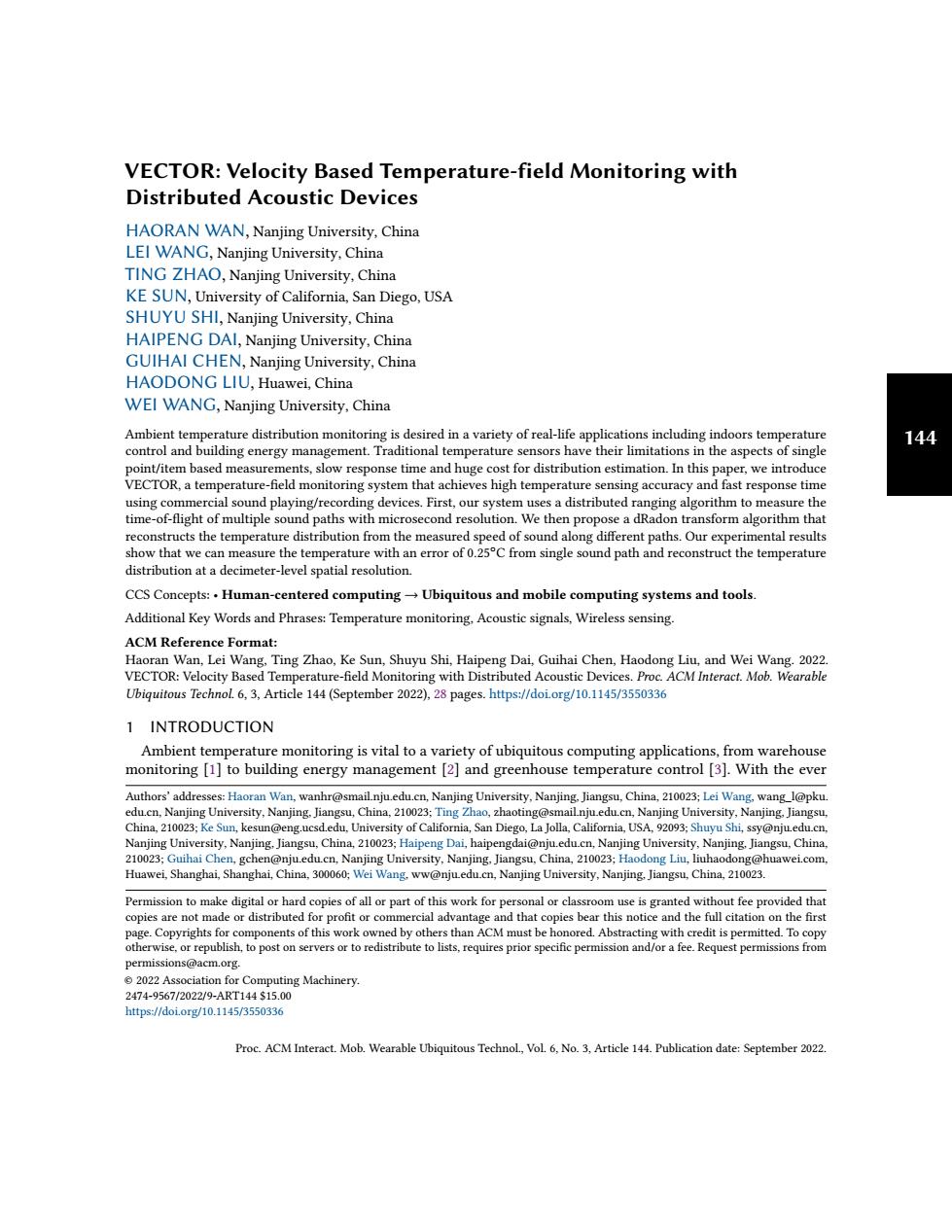正在加载图片...

VECTOR:Velocity Based Temperature-field Monitoring with Distributed Acoustic Devices HAORAN WAN,Nanjing University,China LEI WANG,Nanjing University,China TING ZHAO,Nanjing University,China KE SUN,University of California,San Diego,USA SHUYU SHI,Nanjing University,China HAIPENG DAl,Nanjing University,China GUIHAI CHEN,Nanjing University,China HAODONG LIU,Huawei,China WEI WANG,Nanjing University,China Ambient temperature distribution monitoring is desired in a variety of real-life applications including indoors temperature 144 control and building energy management.Traditional temperature sensors have their limitations in the aspects of single point/item based measurements,slow response time and huge cost for distribution estimation.In this paper,we introduce VECTOR,a temperature-field monitoring system that achieves high temperature sensing accuracy and fast response time using commercial sound playing/recording devices.First,our system uses a distributed ranging algorithm to measure the time-of-flight of multiple sound paths with microsecond resolution.We then propose a dRadon transform algorithm that reconstructs the temperature distribution from the measured speed of sound along different paths.Our experimental results show that we can measure the temperature with an error of 0.25C from single sound path and reconstruct the temperature distribution at a decimeter-level spatial resolution. CCS Concepts:Human-centered computing-Ubiquitous and mobile computing systems and tools. Additional Key Words and Phrases:Temperature monitoring.Acoustic signals,Wireless sensing. ACM Reference Format: Haoran Wan,Lei Wang,Ting Zhao,Ke Sun,Shuyu Shi,Haipeng Dai,Guihai Chen,Haodong Liu,and Wei Wang.2022. VECTOR:Velocity Based Temperature-field Monitoring with Distributed Acoustic Devices.Proc.ACM Interact.Mob.Wearable Ubiquitous Technol 6,3,Article 144(September 2022),28 pages.https://doiorg/10.1145/3550336 1 INTRODUCTION Ambient temperature monitoring is vital to a variety of ubiquitous computing applications,from warehouse monitoring [1]to building energy management [2]and greenhouse temperature control [3].With the ever Authors'addresses:Haoran Wan,wanhr@smail.nju.edu.cn,Nanjing University,Nanjing,Jiangsu,China,210023;Lei Wang,wang_l@pku. edu.cn,Nanjing University,Nanjing.Jiangsu,China,210023;Ting Zhao,zhaoting@smailnju.edu.cn,Nanjing University,Nanjing,Jiangsu, China,210023;Ke Sun,kesun@eng.ucsd.edu,University of California,San Diego,La Jolla,California,USA,92093;Shuyu Shi,ssy@nju.edu.cn, Nanjing University,Nanjing,Jiangsu,China,210023;Haipeng Dai,haipengdai@nju.edu.cn,Nanjing University,Nanjing.Jiangsu,China, 210023;Guihai Chen,gchen@nju.edu.cn,Nanjing University,Nanjing,Jiangsu,China,210023;Haodong Liu,liuhaodong@huawei.com, Huawei,Shanghai,Shanghai,China,300060;Wei Wang.ww@nju.edu.cn,Nanjing University,Nanjing.Jiangsu,China,210023. Permission to make digital or hard copies of all or part of this work for personal or classroom use is granted without fee provided that copies are not made or distributed for profit or commercial advantage and that copies bear this notice and the full citation on the first page.Copyrights for components of this work owned by others than ACM must be honored.Abstracting with credit is permitted.To copy otherwise,or republish,to post on servers or to redistribute to lists,requires prior specific permission and/or a fee.Request permissions from permissions@acm.org. 2022 Association for Computing Machinery. 2474-9567/2022/9-ART144$15.00 https:/doi.org/10.1145/3550336 Proc.ACM Interact.Mob.Wearable Ubiquitous Technol.,Vol.6,No.3,Article 144.Publication date:September 2022.144 VECTOR: Velocity Based Temperature-field Monitoring with Distributed Acoustic Devices HAORAN WAN, Nanjing University, China LEI WANG, Nanjing University, China TING ZHAO, Nanjing University, China KE SUN, University of California, San Diego, USA SHUYU SHI, Nanjing University, China HAIPENG DAI, Nanjing University, China GUIHAI CHEN, Nanjing University, China HAODONG LIU, Huawei, China WEI WANG, Nanjing University, China Ambient temperature distribution monitoring is desired in a variety of real-life applications including indoors temperature control and building energy management. Traditional temperature sensors have their limitations in the aspects of single point/item based measurements, slow response time and huge cost for distribution estimation. In this paper, we introduce VECTOR, a temperature-field monitoring system that achieves high temperature sensing accuracy and fast response time using commercial sound playing/recording devices. First, our system uses a distributed ranging algorithm to measure the time-of-flight of multiple sound paths with microsecond resolution. We then propose a dRadon transform algorithm that reconstructs the temperature distribution from the measured speed of sound along different paths. Our experimental results show that we can measure the temperature with an error of 0.25◦C from single sound path and reconstruct the temperature distribution at a decimeter-level spatial resolution. CCS Concepts: • Human-centered computing → Ubiquitous and mobile computing systems and tools. Additional Key Words and Phrases: Temperature monitoring, Acoustic signals, Wireless sensing. ACM Reference Format: Haoran Wan, Lei Wang, Ting Zhao, Ke Sun, Shuyu Shi, Haipeng Dai, Guihai Chen, Haodong Liu, and Wei Wang. 2022. VECTOR: Velocity Based Temperature-field Monitoring with Distributed Acoustic Devices. Proc. ACM Interact. Mob. Wearable Ubiquitous Technol. 6, 3, Article 144 (September 2022), 28 pages. https://doi.org/10.1145/3550336 1 INTRODUCTION Ambient temperature monitoring is vital to a variety of ubiquitous computing applications, from warehouse monitoring [1] to building energy management [2] and greenhouse temperature control [3]. With the ever Authors’ addresses: Haoran Wan, wanhr@smail.nju.edu.cn, Nanjing University, Nanjing, Jiangsu, China, 210023; Lei Wang, wang_l@pku. edu.cn, Nanjing University, Nanjing, Jiangsu, China, 210023; Ting Zhao, zhaoting@smail.nju.edu.cn, Nanjing University, Nanjing, Jiangsu, China, 210023; Ke Sun, kesun@eng.ucsd.edu, University of California, San Diego, La Jolla, California, USA, 92093; Shuyu Shi, ssy@nju.edu.cn, Nanjing University, Nanjing, Jiangsu, China, 210023; Haipeng Dai, haipengdai@nju.edu.cn, Nanjing University, Nanjing, Jiangsu, China, 210023; Guihai Chen, gchen@nju.edu.cn, Nanjing University, Nanjing, Jiangsu, China, 210023; Haodong Liu, liuhaodong@huawei.com, Huawei, Shanghai, Shanghai, China, 300060; Wei Wang, ww@nju.edu.cn, Nanjing University, Nanjing, Jiangsu, China, 210023. Permission to make digital or hard copies of all or part of this work for personal or classroom use is granted without fee provided that copies are not made or distributed for profit or commercial advantage and that copies bear this notice and the full citation on the first page. Copyrights for components of this work owned by others than ACM must be honored. Abstracting with credit is permitted. To copy otherwise, or republish, to post on servers or to redistribute to lists, requires prior specific permission and/or a fee. Request permissions from permissions@acm.org. © 2022 Association for Computing Machinery. 2474-9567/2022/9-ART144 $15.00 https://doi.org/10.1145/3550336 Proc. ACM Interact. Mob. Wearable Ubiquitous Technol., Vol. 6, No. 3, Article 144. Publication date: September 2022